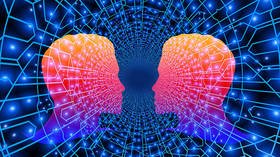Digital immortality: Transhumanism may hold key to eternal life, along with multiple caveats & ethical dilemmas

Some people hope to cheat death by storing their consciousness digitally. Science isn’t quite there yet, but we’ve done enough brain and memory research to have immediate implications – and to start asking uncomfortable questions.
The idea of attaining de facto immortality by translating your brain into code and storing your personality as a digital copy online has been captivating people’s imagination for quite some time. It is particularly popular among transhumanists, people who advocate enhancing human intellect and physiology through the most sophisticated technology available.
As the most technologically advanced nations around the world pour resources into brain studies and yesterday’s science fiction becomes reality, it might seem that humanity is nearing a breakthrough in this field. Could the ability to become a “ghost in the shell” – like in the iconic cyberpunk Japanese manga, or the 2017 film – be just around the corner?
Where do things stand?
Before we can digitize the human brain, we have to fully understand it – and scientists are hard at work trying to figure it out.
Since 2013, the international Brain Initiative project has been mapping the brain in order to revolutionize our understanding of the body’s most mysterious organ, with the goal of improving how we “treat, prevent, and cure disorders of the brain.” The Swiss Blue Brain Project is digitally reconstructing the brains of rodents with a view to being able to use the technology on human brains.
Also on rt.com Facebook to buy startup that lets people control computers with their mindMeanwhile, the US military’s DARPA agency is pouring money into researching brain-machine interfaces that could allow soldiers to do things like control drones with their minds — and Elon Musk’s ‘Neuralink’ is working on creating “mind-reading” AI implants, which will allow human and machine intelligence to work in “symbiosis.”
And still, scientists still don’t know some of the basic things they’ll need to know if at some point it comes to copying and pasting a brain. Like, how much space would it take?
Despite all our limitations, humans don’t ‘run out’ of memory like a mere computer would – and there are massively varying estimations of how much space would be needed, with the higher end being somewhere around 2.5 petabytes (one petabyte is 1,000 terabytes). In plainer terms, that’s enough to hold about three million hours of Netflix shows. “You would have to leave the TV running continuously for more than 300 years to use up all that storage,” Paul Reber, professor of psychology at Northwestern University, wrote in the Scientific American.
Memory manipulation
Memories are a large part of what makes us who we are, and neuroscientists have been figuring out how they work… and, potentially, how to alter them.
Erasing bad memories brings back visions of another film, 2004’s ‘Eternal Sunshine of the Spotless Mind.’ Olga Ivashkina, acting head of the neuroscience laboratory at the Russian National Research Center Kurchatov Institute – one of the nation’s leading research and development facilities – told RT that her laboratory has made progress in understanding the memory processes and even directly conjuring some memories… though only in mice so far.
Another line of study is concerned with the opposite – how to make the brain forget certain memories without affecting the others. “We study various forms of memory. A traumatic one, for example, when a person develops post-traumatic stress disorder (PTSD) after taking part in military action, or living through an emergency situation,” Ivashkina said. Her colleagues at the Kurchatov Institute “are looking for ways to selectively erase it.”
Although such techniques might come as a blessing to many modern war veterans suffering from PTSD, they could obviously have much more nefarious applications.
“Affecting memory chemically, physically or technologically? Yes, it is possible,” Tatyana Chernigovskaya, a prominent neuroscientist with the Russian Academy of Education, admitted. She also spoke of the quite well-studied phenomenon of false memories – situations, in which a person or even a group of people recall something that did not happen, or happened differently from how they remember it. No digital manipulation necessary.
We are not yet at a point when we can implant memory chips capable of replacing our memories with some other ones. Yet, tomorrow or the day after, it could certainly become reality.
Without ethical safeguards, Ivashkina warns, humanity might one day find itself in a dystopia like that of the cult movie ‘Blade Runner,’ where it will be impossible to tell which memories are implanted and which ones are genuine.
From concept to reality
Ultimately, Ivashkina believes digital immortality is theoretically possible, albeit in the “distant future.”
“We do not have technologies allowing us to copy one’s personality somewhere for it to live in a digital world,” she said. She is, however, quite optimistic about the development of such technology in the future.
At some point, we will be able to understand what exactly in our brain makes us ‘us’ and how we can transfer it to an electronic medium.
Maybe all it would take is a different perspective on things. But despite the vast amounts of data on human brain activity and all the cutting-edge analytical tools at the disposal of today’s researchers, Tatyana Chernigovskaya is skeptical.
“The problem is that we need a landmark theoretical breakthrough. Yet, it is not clear where it could come from,” she said. “The question is what to do with all this data.”

A person isn’t just data you can copy
Chernigovskaya doesn’t think digital immortality is attainable. Even if we were to be able to translate memories into ones and zeroes, a human being is more than just memories.
“People do not really understand what it is all about. The point is that one needs to transfer consciousness… to an external storage device. It should not be just a set of memories but a fully functioning personality,” Chernigovskaya told RT, adding that it cannot be done for many reasons.
In terms of neurophysiology, the human neural net is constantly changing, so even if all the hurdles are cleared, picking the right moment for “recording yourself” would not be an easy task. Doing that right ahead of death might not be a good idea either, Chernigovskaya explains, as the brain is hardly at its peak at that stage.
The 2014 film ‘Transcendence’ gives a bleak vision of what might happen with someone who gets digitally uploaded to stave off death. While the procedure is successful, Johnny Depp’s character soon finds his digital self seeking to control the world. Hardly an endorsement for transhumanism, to be sure – but let’s deal with that when we get there.
Stark warnings
For every scientist enthusiastic about the endless possibilities of ‘enhancing’ the human brain and body, however, there seems to be another offering stark warnings about the dangers of heading down such a path.
It’s not just memory and consciousness uploading that transhumanists are interested in, either. For some, the idea of replacing healthy body parts with enhanced tech versions, creating a kind of cyborg world, is also on the cards. Why have normal legs and arms, they argue, when you could replace them with artificial blades which “allow you to perform better”?
This flavor of progress may in fact lead to widening social inequality, according to many experts, including Nidhal Guessoum, a professor at the American University of Sharjah, who has warned that only the richest among us will be able to afford to ‘upgrade’ themselves. This creates the frightening prospect of one class of highly technologically advanced humans being literally ‘superior’ to the rest – in technological function at least.
In the worst doomsday scenario, some warn that if our memories and consciousnesses are uploaded to devices – and connected to the internet – our brains could be hacked, the hackers gaining the ability to control our actions.
Another major concern of Guessoum’s is how exactly humanity will set “limits” in the field and determine what kinds of human modifications will be allowed “while still preserving ‘human’ nature.”
The big question is, once this Pandora’s box has been opened, how will society and governments decide how far is too far?
Like this story? Share it with a friend!














